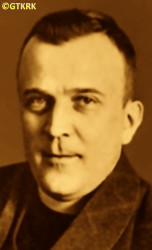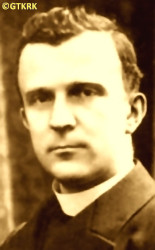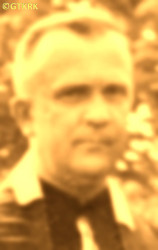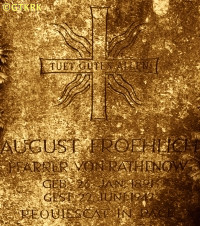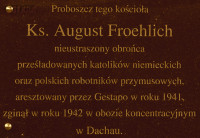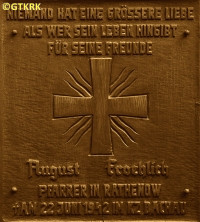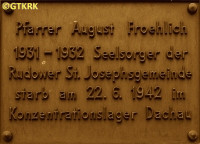Roman Catholic
St Sigismund parish
05-507 Słomczyn
85 Wiślana Str.
Konstancin deanery
Warsaw archdiocese, Poland
full list:
displayClick to display full list

searchClick to search full list by categories
wyświetlKliknij by wyświetlić pełną listę po polsku

szukajKliknij by przeszukać listę wg kategorii po polsku

Martyrology of the clergy — Poland
XX century (1914 – 1989)
personal data
religious status
Servant of God
surname
FROEHLICH
forename(s)
Augustus (pl. August)
function
diocesan priest
creed
Latin (Roman Catholic) Church RCmore on
en.wikipedia.org
[access: 2014.09.21]
diocese / province
Berlin diocesemore on
en.wikipedia.org
[access: 2013.12.04]
Wrocław diocesemore on
en.wikipedia.org
[access: 2013.05.19]
honorary titles
„Iron Cross” i.e. Germ. „Eisernes Kreuz” (German Empire) — 1st classmore on
„Iron Cross” i.e. Germ. „Eisernes Kreuz” (German Empire) – 1st_class
(1918)
„Iron Cross” i.e. Germ. „Eisernes Kreuz” (German Empire) — 2nd classmore on
„Iron Cross” i.e. Germ. „Eisernes Kreuz” (German Empire) – 2nd_class
(1918)
nationality
German
date and place
of death
22.06.1942

KL Dachauconcentration camp
today: Dachau, Upper Bavaria reg., Bavaria state, Germany
more on
en.wikipedia.org
[access: 2016.05.30]
details of death
After outbreak in 06.1914 of the World War I drafted in 12.1914 as a seminarian into 1st Caesar Alexander Grenadiers' Regiment of the German Imperial Army. As a Catholic, unfavorably received by the mostly Protestant Regiment. From 06.1915 on the Eastern Front. On 03.07.1915 near Zamość, during the retreat of the Russians, in connection with the Russian defeat in the Battle of Gorlice 02‐05.05.1915, wounded in a skirmish with the Russians. Shot in the face, then bayoneted by the Russians, who did not intend to take the wounded prisoners, and wounded in the neck. Found by the Germans the next day. After convalescence in Głogów, sent to the Western — French Front. In the spring of 1918 awarded the Iron Cross 1st and 2nd Class and promoted to second lieutenant. Then, during an air attack, prob. English, wounded again. On 08.10.1918 taken POW by the British. Released in 1920, after the end of World War I.
In 1932 forced by German national socialist to leave Berlin–Rudow parish.
From 1934 publicly attacked and harassed by the–then ruling National–Socialist NSDAP party in Germany.
In 04.1935 interrogated for the first time by German Gestapo in Koszalin.
After German and Russian invasion of Poland in 09.1939 and start of the World War II interceded in 1941 for Polish slave workers in Emil Busch AG company in Rathenow.
On 20.03.1941 arrested by the Germans for the time.
After 3 weeks released on bail.
On 15.05.1941 however arrested again by the Germ. Geheime Staatspolizei (Eng. Secret State Police), Gestapo, in Rathenow.
Jailed in Potsdam.
Next on 28‐31.07.1941 transported next to KL Buchenwald concentration camp.
There, the reason for his imprisonment was recorded in the camp books as follows: Germ. „Grund: hat Beschwerden von polnischen Zivilarbeiterinnen an die Arbeitgeber weitergeleitet” (Eng. „Reason: has forwarded complaints from Polish civilian workers to the employers”).
On 13.03.1942 moved to KL Ravensbrück concentration camp.
Tortured and harassed.
Finally on 20.05.1942 taken to KL Dachau concentration camp where after few days — totally exhausted — perished.
According to the death certificate, prepared in KL Dachau, the „honest” otherwise German „medical doctors” and formalists — and at the same time, unrivaled fairy tale spinners — noted that the cause of death was Germ. „Versagen von Herz und Kreislauf, bei Darmkatarrch” (Eng. „Heart and circulatory failure, due to intestinal catarrh”).
prisoner camp's numbers
30107Click to display source page (KL DachauClick to display the description), 1218Click to display source page (KL RavensbrückClick to display the description), 1701Click to display source page (KL BuchenwaldClick to display the description)
cause of death
extermination: exhaustion and starvation
perpetrators
Germans
sites and events
KL DachauClick to display the description, KL RavensbrückClick to display the description, KL BuchenwaldClick to display the description, Ribbentrop‐MolotovClick to display the description, Pius XI's encyclicalsClick to display the description
date and place
of birth
26.01.1891Birth certification on:
skanoteka.genealodzy.pl
[access: 2025.08.19]

Królewska Hutatoday: Chorzów /from 1934/, Chorzów city pov., Silesia voiv., Poland
more on
en.wikipedia.org
[access: 2021.12.18]
parents
FROEHLICH Anthony
🞲 ?, ? — 🕆 ?, ?

SOCK Joanna
🞲 ?, ? — 🕆 ?, ?
baptism
07.03.1880Birth certification on:
skanoteka.genealodzy.pl
[access: 2025.08.19]

Królewska Hutatoday: Chorzów /from 1934/, Chorzów city pov., Silesia voiv., Poland
more on
en.wikipedia.org
[access: 2021.12.18]
St Barbara RC church
presbyter (holy orders)
ordination
19.06.1921

Wrocławtoday: Wrocław city pov., Lower Silesia voiv., Poland
more on
en.wikipedia.org
[access: 2021.04.02]
St John the Baptist RC archcathedral churchmore on
pl.wikipedia.org
[access: 2021.12.19]
positions held
1937 – 1941
parish priest — Rathenowtoday: Havelland dist., Brandenburg state, Germany
more on
en.wikipedia.org
[access: 2020.11.11] ⋄ St George RC parish ⋄ Potsdamtoday: Brandenburg state, Germany
more on
en.wikipedia.org
[access: 2021.04.02] RC deanery
1932 – 1937
curatus/rector/expositus — Drawsko Pomorskietoday: Drawsko Pomorskie gm., Drawsko Pomorskie pov., West Pomerania voiv., Poland
more on
en.wikipedia.org
[access: 2022.08.05] ⋄ St Paul the Apostle RC church
1931 – 1932
rector — Berlin‐Rudowlocality in Berlin, Alt‐Rudow in Neukölln borough
today: Berlin state, Germany
more on
en.wikipedia.org
[access: 2022.01.07] ⋄ St Joseph RC church
1929 – 1931
vicar — Berlin‐Charlottenburglocality in Berlin, Charlottenburg‐Wilmersdorf borough
today: Berlin state, Germany
more on
en.wikipedia.org
[access: 2022.01.07] ⋄ St Thomas RC parish
1928 – 1929
vicar — Berlin‐Spandaulocality in Berlin, Spandau borough
today: Berlin state, Germany
more on
en.wikipedia.org
[access: 2022.01.07] ⋄ Blessed Virgin Mary RC parish ⋄ Potsdamtoday: Brandenburg state, Germany
more on
en.wikipedia.org
[access: 2021.04.02] RC deanery
1924 – 1928
vicar — Berlintoday: Berlin state, Germany
more on
en.wikipedia.org
[access: 2020.07.31] ⋄ St Boniface RC parish
1921 – 1924
vicar — Berlin‐Neuköllnlocality in Berlin, Neukölln borough
today: Berlin state, Germany
more on
en.wikipedia.org
[access: 2021.12.18] ⋄ St Edward RC parish
1920 – 1921
student — Wrocławtoday: Wrocław city pov., Lower Silesia voiv., Poland
more on
en.wikipedia.org
[access: 2021.04.02] ⋄ philosophy and theology, Department of Catholic Theology, University of Wrocław [i.e. University of Wrocław (since 1945) / Frederic Wilhelm University of Silesia (1911‐1945) / Royal University i.e. Breslau Academy (1816‐1911)]
1912 – 1914
student — Wrocławtoday: Wrocław city pov., Lower Silesia voiv., Poland
more on
en.wikipedia.org
[access: 2021.04.02] ⋄ philosophy and theology, Department of Catholic Theology, University of Wrocław [i.e. University of Wrocław (since 1945) / Frederic Wilhelm University of Silesia (1911‐1945) / Royal University i.e. Breslau Academy (1816‐1911)]
sites and events
descriptions
KL Dachau: KL Dachau in German Bavaria, set up in 1933, became the main German Germ. Konzentrationslager (Eng. concentration camp) KL for Catholic priests and religious during World War II: On c. 09.11.1940, Reichsführer‐SS Heinrich Himmler, head of the SS, Gestapo and German police, as a result of the Vatican's intervention, decided to transfer all clergymen detained in various concentration camps to KL Dachau camp. The first major transports took place on 08.12.1940. In KL Dachau Germans held approx. 3,000 priests, including 1,800 Poles. The priests were forced to slave labor in the Germ. „Die Plantage” — the largest herb garden in Europe, managed by the genocidal SS, consisting of many greenhouses, laboratory buildings and arable land, where experiments with new natural medicines were conducted — for many hours, without breaks, without protective clothing, no food. They slaved in construction, e.g. of camp's crematorium. In the barracks ruled hunger, freezing cold in the winter and suffocating heat during the summer, especially acute in 1941‐1942. Prisoners suffered from bouts of illnesses, including tuberculosis. Many were victims of murderous „medical experiments” — in 11.1942 c. 20 were given phlegmon injections; in 07.1942 to 05.1944 c. 120 were used by for malaria experiments. More than 750 Polish clerics where murdered by the Germans, some brought to TA Hartheim euthanasia centre set up in Schloss Hartheim in Austria and murdered in gas chambers. At its peak KL Dachau concentration camps’ system had nearly 100 slave labour sub‐camps located throughout southern Germany and Austria. There were c. 32,000 documented deaths at the camp, and thousands perished without a trace. C. 10,000 of the 30,000 inmates were found sick at the time of liberation, on 29.04.1945, by the USA troops… (more on: www.kz-gedenkstaette-dachau.deClick to attempt to display webpage
[access: 2013.08.10], en.wikipedia.orgClick to attempt to display webpage
[access: 2016.05.30])
KL Ravensbrück: German Germ. Konzentrationslager (Eng. concentration camp) KL for women, operational in 1939‐1945. Approx. 135,000 women and children were held captive, approx. 90,000 of which perished, among them 40,000 Poles (some of them underwent pseudo‐„medical” experiments). In sub‐camps approx. 20,000 men were held. (more on: pl.wikipedia.orgClick to attempt to display webpage
[access: 2013.06.23])
KL Buchenwald: In German Germ. Konzentrationslager (Eng. concentration camp) KL Buchenwald concentration camp, founded in 1937 and operational till 1945, Germans held c. 238,380 prisoners and murdered approx. 56,000 of them, among them thousands of Poles. Prisoners were victims of pseudo‐scientific experiments, conducted among others by Behring‐Werke from Marburg and Robert Koch Institute from Berlin companies. They slaved for Gustloff in Weimar and Fritz‐Sauckel companies manufacturing armaments. To support Erla‐Maschinenwerk GmbH in Leipzig, Junkers in Schönebeck (airplanes) and Rautal in Wernigerode Germans organized special sub‐camps. In 1945 there were more than 100 such sub‐camps. Dora concentration camp was initially one of them, as well as KL Ravensbrück sub‐camps (from 08.1944). On 08.04.1945 Polish prisoner, Mr Guido Damazyn, used clandestinely constructed short wave transmitter to sent, together with a Russian prisoner, a short message begging for help. It was received and he got a reply: „KZ Bu. Hold out. Rushing to your aid. Staff of Third Army” (American). Three days later the camp was liberated. (more on: www.buchenwald.deClick to attempt to display webpage
[access: 2013.08.10], en.wikipedia.orgClick to attempt to display webpage
[access: 2013.08.10])
Ribbentrop‐Molotov: Genocidal Russian‐German alliance pact between Russian leader Joseph Stalin and German leader Adolf Hitler signed on 23.08.1939 in Moscow by respective foreign ministers, Mr. Vyacheslav Molotov for Russia and Joachim von Ribbentrop for Germany. The pact sanctioned and was the direct cause of joint Russian and German invasion of Poland and the outbreak of the World War II in 09.1939. In a political sense, the pact was an attempt to restore the status quo ante before 1914, with one exception, namely the „commercial” exchange of the so‐called „Kingdom of Poland”, which in 1914 was part of the Russian Empire, fore Eastern Galicia (today's western Ukraine), in 1914 belonging to the Austro‐Hungarian Empire. Galicia, including Lviv, was to be taken over by the Russians, the „Kingdom of Poland” — under the name of the General Governorate — Germany. The resultant „war was one of the greatest calamities and dramas of humanity in history, for two atheistic and anti‐Christian ideologies — national and international socialism — rejected God and His fifth Decalogue commandment: Thou shall not kill!” (Abp Stanislav Gądecki, 01.09.2019). The decisions taken — backed up by the betrayal of the formal allies of Poland, France and Germany, which on 12.09.1939, at a joint conference in Abbeville, decided not to provide aid to attacked Poland and not to take military action against Germany (a clear breach of treaty obligations with Poland) — were on 28.09.1939 slightly altered and made more precise when a treaty on „German‐Russian boundaries and friendship” was agreed by the same murderous signatories. One of its findings was establishment of spheres of influence in Central and Eastern Europe and in consequence IV partition of Poland. In one of its secret annexes agreed, that: „the Signatories will not tolerate on its respective territories any Polish propaganda that affects the territory of the other Side. On their respective territories they will suppress all such propaganda and inform each other of the measures taken to accomplish it”. The agreements resulted in a series of meeting between two genocidal organization representing both sides — German Gestapo and Russian NKVD when coordination of efforts to exterminate Polish intelligentsia and Polish leading classes (in Germany called «Intelligenzaktion», in Russia took the form of Katyń massacres) where discussed. Resulted in deaths of hundreds of thousands of Polish intelligentsia, including thousands of priests presented here, and tens of millions of ordinary people,. The results of this Russian‐German pact lasted till 1989 and are still in evidence even today. (more on: en.wikipedia.orgClick to attempt to display webpage
[access: 2015.09.30])
Pius XI's encyclicals: Facing the creation of two totalitarian systems in Europe, which seemed to compete with each other, though there were more similarities than contradictions between them, Pope Pius XI issued in 03.1937 (within 5 days) two encyclicals. In the „Mit brennender Sorge” (Eng. „With Burning Concern”) published on 14.03.1938, condemned the national socialism prevailing in Germany. The Pope wrote: „Whoever, following the old Germanic‐pre‐Christian beliefs, puts various impersonal fate in the place of a personal God, denies the wisdom of God and Providence […], whoever exalts earthly values: race or nation, or state, or state system, representatives of state power or other fundamental values of human society, […] and makes them the highest standard of all values, including religious ones, and idolizes them, this one […] is far from true faith in God and from a worldview corresponding to such faith”. On 19.03.1937, published „Divini Redemptoris” (Eng. „Divine Redeemer”), in which criticized Russian communism, dialectical materialism and the class struggle theory. The Pope wrote: „Communism deprives man of freedom, and therefore the spiritual basis of all life norms. It deprives the human person of all his dignity and any moral support with which he could resist the onslaught of blind passions […] This is the new gospel that Bolshevik and godless communism preaches as a message of salvation and redemption of humanity”… Pius XI demanded that the established human law be subjected to the natural law of God , recommended the implementation of the ideal of a Christian state and society, and called on Catholics to resist. Two years later, National Socialist Germany and Communist Russia came together and started World War II. (more on: www.vatican.vaClick to attempt to display webpage
[access: 2023.05.28], www.vatican.vaClick to attempt to display webpage
[access: 2023.05.28])
sources
personal:
pl.wikipedia.orgClick to attempt to display webpage
[access: 2012.11.23], www.wykop.plClick to attempt to display webpage
[access: 2013.05.19], newsaints.faithweb.comClick to attempt to display webpage
[access: 2025.04.13], skanoteka.genealodzy.plClick to attempt to display webpage
[access: 2025.08.19], www.ferajna.euClick to attempt to display webpage
[access: 2019.02.02]
bibliographical:
„International Tracing Service (ITS), Bad Arolsen, GermanyClick to display source page”, Arolsen Archives
original images:
www.amazon.comClick to attempt to display webpage
[access: 2019.02.02], commons.wikimedia.orgClick to attempt to display webpage
[access: 2019.02.02], www.gdw-berlin.deClick to attempt to display webpage
[access: 2019.02.02], www.ferajna.euClick to attempt to display webpage
[access: 2019.02.02], pl.wikipedia.orgClick to attempt to display webpage
[access: 2013.12.04], www.ferajna.euClick to attempt to display webpage
[access: 2019.02.02], commons.wikimedia.orgClick to attempt to display webpage
[access: 2019.02.02], commons.wikimedia.orgClick to attempt to display webpage
[access: 2017.01.21]
LETTER to CUSTODIAN/ADMINISTRATOR
If you have an Email client on your communicator/computer — such as Mozilla Thunderbird, Windows Mail or Microsoft Outlook, described at WikipediaPatrz:
en.wikipedia.org, among others — try the link below, please:
LETTER to CUSTODIAN/ADMINISTRATORClick and try to call your own Email client
If however you do not run such a client or the above link is not active please send an email to the Custodian/Administrator using your account — in your customary email/correspondence engine — at the following address:

giving the following as the subject:
MARTYROLOGY: FROEHLICH Augustus
To return to the biography press below:
 Click to return to biography
Click to return to biography








